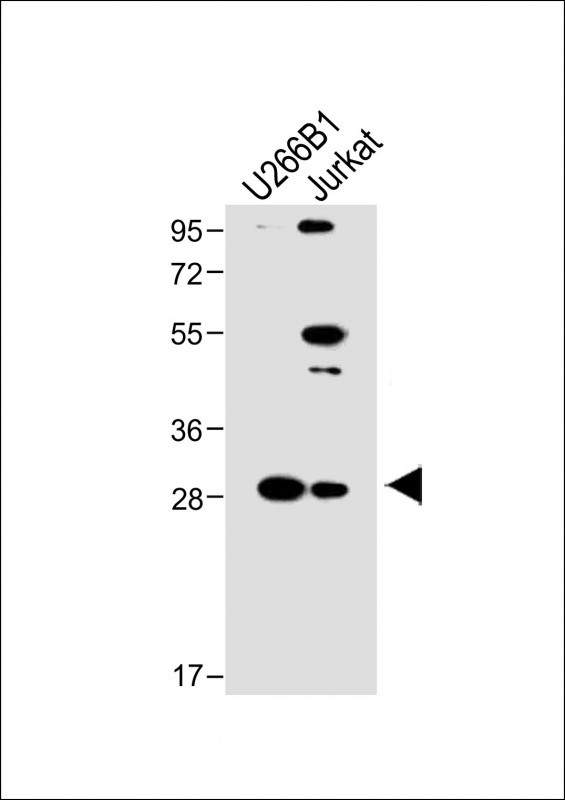
| WB | 咨询技术 | Human,Mouse,Rat |
| IF | 咨询技术 | Human,Mouse,Rat |
| IHC | 咨询技术 | Human,Mouse,Rat |
| ICC | 技术咨询 | Human,Mouse,Rat |
| FCM | 咨询技术 | Human,Mouse,Rat |
| Elisa | 咨询技术 | Human,Mouse,Rat |
| Aliases | Lysosomal-associated transmembrane protein 5, Lysosomal-associated multitransmembrane protein 5, Retinoic acid-inducible E3 protein, LAPTM5, KIAA0085 |
| Entrez GeneID | 7805 |
| WB Predicted band size | 29.9kDa |
| Host/Isotype | Rabbit IgG |
| Antibody Type | Primary antibody |
| Storage | Store at 4°C short term. Aliquot and store at -20°C long term. Avoid freeze/thaw cycles. |
| Species Reactivity | Human |
| Immunogen | This LAPTM5 antibody is generated from rabbits immunized with a KLH conjugated synthetic peptide between 23-49 amino acids from the N-terminal region of human LAPTM5. |
| Formulation | Purified antibody in PBS with 0.05% sodium azide. |
+ +
以下是关于LAPTM5 (N-term)抗体的3篇参考文献及其摘要概括:
---
1. **文献名称**: *LAPTM5 links the ubiquitin-proteasome system to endosomal antigen processing for major histocompatibility complex class II presentation*
**作者**: Saito Y, et al.
**摘要**: 本研究阐明了LAPTM5通过泛素-蛋白酶体系统调控MHC II类抗原呈递的机制。作者使用针对LAPTM5 N端的特异性抗体进行免疫共沉淀和Western blot实验,证实LAPTM5在溶酶体膜上与泛素化蛋白结合,促进抗原加工。研究揭示了其在免疫细胞中的关键作用。
---
2. **文献名称**: *Lysosomal-associated protein transmembrane 5 (LAPTM5) mediates macrophage inflammation in atherosclerosis via NLRP3 signaling*
**作者**: Dong X, et al.
**摘要**: 该研究探讨了LAPTM5在动脉粥样硬化中通过NLRP3炎症小体激活巨噬细胞的机制。通过N端特异性抗体检测LAPTM5在巨噬细胞中的表达和定位,发现其敲减显著抑制促炎因子释放,提示其作为潜在治疗靶点。
---
3. **文献名称**: *LAPTM5 is required for lysosomal integrity and macrophage homeostasis*
**作者**: Marshansky V, et al.
**摘要**: 研究利用LAPTM5 N端抗体进行免疫荧光和免疫印迹分析,发现LAPTM5缺失导致溶酶体膜稳定性受损,影响自噬和细胞凋亡。该蛋白通过维持溶酶体功能在巨噬细胞稳态中起关键作用,与代谢疾病相关。
---
以上文献均通过针对LAPTM5 N端的抗体进行蛋白定位、功能验证及分子机制研究,涵盖免疫调控、疾病模型等方向。如需具体实验细节,建议查阅原文方法部分。
The LAPTM5 (N-term) antibody is a specific immunological tool designed to target the N-terminal region of lysosomal-associated protein transmembrane 5 (LAPTM5), a protein encoded by the *LAPTM5* gene in humans. LAPTM5 belongs to the LAPTM (lysosomal-associated transmembrane protein) family, which is implicated in lysosomal function, intracellular trafficking, and cellular signaling. It is predominantly expressed in immune cells, including hematopoietic cells and macrophages, and plays roles in regulating lysosomal maturation, autophagy, and immune responses. Dysregulation of LAPTM5 has been linked to cancers, inflammatory diseases, and neurodegenerative disorders.
The antibody is commonly used in research to detect endogenous LAPTM5 expression via techniques like Western blotting, immunohistochemistry, and immunofluorescence. By targeting the N-terminal region, the antibody helps study the protein’s localization, post-translational modifications, and interactions with other molecules. Its specificity is validated using knockout controls or siRNA-mediated silencing to confirm minimal cross-reactivity with homologous proteins. Researchers utilize this tool to explore LAPTM5’s involvement in lysosomal dysfunction, immune regulation, and disease mechanisms, particularly in contexts like leukemia, autoimmune conditions, and lysosomal storage disorders. Proper storage conditions and optimized dilution protocols are recommended to maintain antibody performance.
×